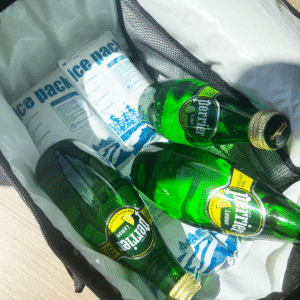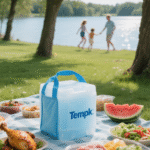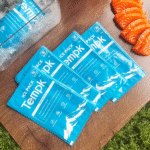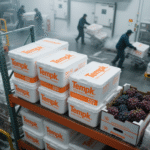If you need rock‑solid frozen performance on the road, knowing how to properly use dry ice in a cooler is the fastest way to keep contents below zero for 24–72 hours. Use safe venting, pre‑chill the box, topload blocks, and size 5-10 رطل لكل 24 ساعات for typical hard coolers. You’ll get a clear step‑by‑step, a calculator, and packing layouts you can repeat on any route.
-
How to properly use dry ice in a cooler step‑by‑step so you maintain sub‑zero temps with safe venting.
-
How much dry ice you actually need using a quick calculator and tested sizing ranges.
-
Which coolers are compatible and vented so pressure never builds.
-
How to travel and dispose safely without risking CO₂ hazards or denied boarding.
-
ما الجديد في 2025 across cold‑chain gear and best practices.
How to properly use dry ice in a cooler, خطوة بخطوة?
إجابة قصيرة: ما قبل التعرّف, wear insulated gloves/eye protection, load items tightly, place dry ice on top, fill side voids, and keep a vent path—never seal airtight. This layout drives cold downward and prevents pressure buildup from CO₂ gas. Label if you travel, and stage/transport in ventilated areas.
لماذا هذا يعمل: Dry ice sits at −78.5 °C and sublimates to CO₂ that must escape. Top placement exploits gravity—cold sinks—so the “ice cap” feeds dense cold across your payload. Tight packing reduces warm spots and slows sublimation. A normal lid closure (not taped) preserves the designed vent path on many hard coolers.
What layering works best to properly use dry ice in a cooler?
Use a four‑layer stack you can set up in five minutes. Wrap blocks in kraft paper or towels, add mixed pellets for even coverage, and fill gaps to stop hot air leaks. هذا how to properly use dry ice in a cooler stack balances hold time with easy access during the trip.
| Layer plan (cooler stack) | What to use | سمك نموذجي | What it does for you |
|---|---|---|---|
| انتشار قاعدة | Pellet/chunk mix wrapped in paper | 0.5–1 in | Evens cold across the floor for quick pull‑down. |
| Payload zone | Items packed tightly | - | Cuts air pockets; slows warming when you open the lid. |
| ملء جانبي | Small pellet bags / crumpled paper | 0.5–1 in | Shields against side heat leaks and jolts. |
| الجزء العلوي | 1–2 dry‑ice blocks + الكريات | 1-2 في | Feeds cold downward the longest; easiest to re‑top. |
نصائح عملية & quick wins
-
ما قبل التعرّف the cooler with sacrificial ice or in a freezer for a few hours.
-
قفازات + حماية العين (loose‑fitting, insulated) beat skin contact and splash hazards.
-
Do not tape the lid—leave the manufacturer’s vent path intact.
-
Crack a window in vehicles; avoid confined rooms and tent interiors.
حالة العالم الحقيقي: A 65‑qt hard cooler for a 36‑hour summer haul used 16 رطل (كتل + الكريات), top‑loaded, with minimal openings. Contents stayed hard‑frozen; the drain/vent path remained unobstructed.
How much dry ice do you need to properly use dry ice in a cooler?
حكم الإبهام: خطة 5-10 رطل لكل 24 ساعات in a typical insulated hard cooler. الكتل تدوم أطول من الكريات; heat, الجدران الرقيقة, and frequent lid openings increase demand. Start mid‑range and add a buffer in hot weather.
Why ranges vary: Sublimation depends on insulation, fill ratio, درجة الحرارة المحيطة, تدفق الهواء, and access frequency. A small change in airflow can sharply raise CO₂ output—another reason to plan conservatively and keep vents open.
Quick calculator: plan how to properly use dry ice in a cooler
Paste into Sheets/Excel and tweak factors as needed:
-
Rate_lb_per_day: start at 7.5 (midpoint of 5–10).
-
ambient_factor: 1.0 رائع | 1.2 دافيء | 1.4 حار.
-
Cooler_Factor: 0.9 premium roto‑molded | 1.0 standard hard | 1.2 thin‑wall/soft.
مثال: 36 ح, حار (1.4), standard hard (1.0) → 16 رطل.
| Cooler volume | Fill level | Hours target | شرق . الثلج الجاف | ماذا يعني لك |
|---|---|---|---|---|
| 20–35 qt | 70–90% | 18–24 h | 5-8 رطل | Short trips/tailgates; pre‑chill for best results. |
| 45–65 qt | 80–100% | 24-36 ساعة | 10-16 رطل | One‑to‑two‑day road trips; top‑heavy layout preferred. |
| 65–85 qt | 80–100% | 36-48 ح | 15–22 lb | Weekend camping; group items to limit lid time. |
| 100+ كيو تي | 85–100% | 48-72 ح | 25-35 رطل | Long hauls/hot weather; add side fill and label clearly. |
| ملحوظة: 1 lb of dry ice = ~250 L of CO₂—venting isn’t optional; إنه أمر بالغ الأهمية. |
Is your cooler compatible—and how do you confirm venting?
إجابة قصيرة: Use a dry‑ice‑compatible hard cooler; many are designed to vent slightly by default. Soft coolers are often not compatible. Confirm your exact model, inspect gaskets, avoid blocking drains, and never modify or tape shut vents or seams.
What “compatible” means: Materials and seals tolerate cryogenic cold; gaskets and drains allow CO₂ to escape; brittle plastics and glass are avoided. A quick sanity check—model page mentions dry‑ice use, the lid closes normally (ليس محكم), and drain paths remain open.
Flying? How to properly use dry ice in a cooler on planes
Use airline‑approved packaging. نحن. passenger rules cap dry ice at 2.5 kg (5.5 رطل) per traveler, require venting (no airtight seals), and clear “Dry ice/UN1845” marking with net quantity. Expect agents to verify weight, علامات, and lid closure. Always check your carrier’s specifics before departure.
How to properly use dry ice in a cooler for food & مشروبات?
إجابة قصيرة: Keep frozen items closest to the dry‑ice cap with a paper wrap barrier; place chilled items farther away or separated by a divider. للأحمال المختلطة, add a small buffer of regular ice below the divider to protect delicate items from over‑freezing.
لماذا يعمل: The top cap drives cold down through frozen goods first; a divider reduces “freezer burn” on fragile packaging. Group by “day of use” to reduce rummaging time and lid openings. Wrap blocks to protect labels and fingers, and use trays or partitions for glass or dent‑prone items.
Common mistakes when you properly use dry ice in a cooler
-
Taping every seam: traps gas and risks rupture—never seal airtight.
-
Indoor storage in small rooms: CO₂ can displace oxygen; keep in ventilated spaces.
-
Soft‑cooler shortcuts: most are not rated for dry ice; stick to compatible hard coolers.
-
Putting dry ice in bottles or thin plastics: thermal shock/shatter risk—avoid entirely.
2025 cold‑chain updates: what changed for your cooler and dry ice
نظرة عامة على الاتجاه (2025): Modeling work refined sublimation estimates and showed airflow and geometry can swing daily loss rates more than you expect. Many hard coolers now ship with default venting designs, and the long‑standing airline rules and labeling best practices remain in force—plan conservatively and keep the vent path open.
Latest improvements at a glance
-
Better sublimation modeling helps right‑size mass and venting for your route.
-
Default‑venting hard coolers reduce user error from over‑sealing.
-
شائع, consistent travel rules simplify planning across carriers.
نظرة السوق: Expect continued adoption of dry‑ice‑compatible hard coolers for food and specialty shipments, often paired with simple data loggers to verify time‑temperature performance. Plan 20–30% extra mass in hot months to cover openings and delays.
التعليمات
س 1: كم من الوقت سوف يجف الجليد في مبرد?
يخطط 5-10 رطل لكل 24 ساعات in a typical hard cooler; كتل تدوم لفترة أطول من الكريات. Hot weather and frequent openings shorten hold time.
Q2: Should I put dry ice on top or bottom?
Top usually lasts longer because cold sinks. Bottom‑loading is convenient for quick grabs but expect faster sublimation.
س 3: Can I sleep near a cooler with dry ice?
Don’t do it in tents or small rooms. CO₂ can displace oxygen. Use well‑ventilated areas only.
س 4: Can I fly with a cooler and dry ice?
Yes—within carrier rules. Typical passenger limit is 2.5 kg per person, ملحوظ, and vented (ليس محكم).
س 5: كيف أتخلص من الجليد الجاف المتبقي?
Let it sublimate in a ventilated place (outdoors if possible). Never in sinks or sealed bins.
ملخص & التوصيات
الوجبات الرئيسية: ل properly use dry ice in a cooler, ما قبل التعرّف, wear PPE, top‑load wrapped blocks, ملء الفراغات, و أبداً ختم محكم. Size mass at 5-10 رطل/يوم, add a hot‑weather buffer, and keep the vent path open. For travel, mark and verify carrier requirements.
الخطوات التالية (your plan):
-
Confirm cooler compatibility and pre‑chill tonight.
-
Use the calculator to size mass; يضيف 20% for heat or frequent access.
-
Pack the four‑layer stack and run a home trial.
-
Traveling? Mark “Dry ice/UN1845,” keep it vented, and carry PPE.
حول Tempk
We are a cold‑chain team focused on practical, validated methods for frozen and chilled transport. We design lane‑tested cooler kits, write clear SOPs, and supply sizing charts so your cooler performs on the first try. Our guidance aligns with EHS and carrier rules, and our packaging choices prioritize safety, يكلف, and product quality.
CTA: Ready to remove guesswork? Contact Tempk for a 15‑minute cooler + dry‑ice review and get a custom chart for your next route.
























